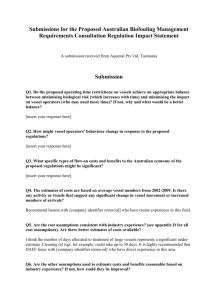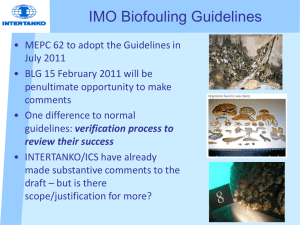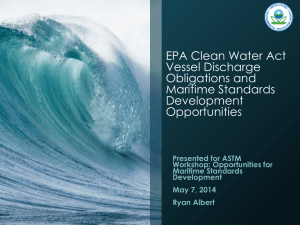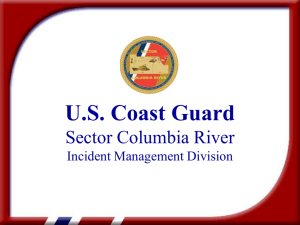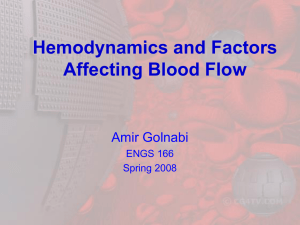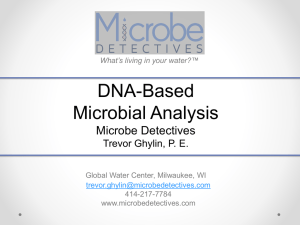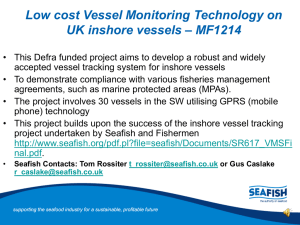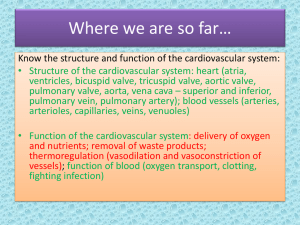Submissions for the Proposed Australian Biofouling Management
advertisement
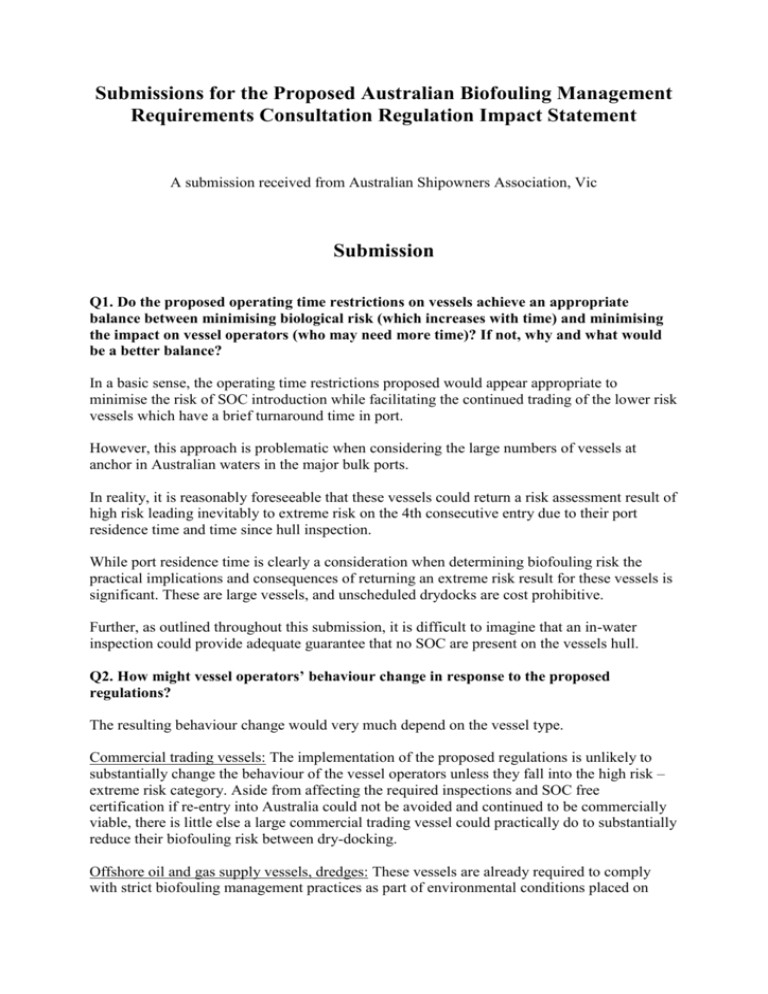
Submissions for the Proposed Australian Biofouling Management Requirements Consultation Regulation Impact Statement A submission received from Australian Shipowners Association, Vic Submission Q1. Do the proposed operating time restrictions on vessels achieve an appropriate balance between minimising biological risk (which increases with time) and minimising the impact on vessel operators (who may need more time)? If not, why and what would be a better balance? In a basic sense, the operating time restrictions proposed would appear appropriate to minimise the risk of SOC introduction while facilitating the continued trading of the lower risk vessels which have a brief turnaround time in port. However, this approach is problematic when considering the large numbers of vessels at anchor in Australian waters in the major bulk ports. In reality, it is reasonably foreseeable that these vessels could return a risk assessment result of high risk leading inevitably to extreme risk on the 4th consecutive entry due to their port residence time and time since hull inspection. While port residence time is clearly a consideration when determining biofouling risk the practical implications and consequences of returning an extreme risk result for these vessels is significant. These are large vessels, and unscheduled drydocks are cost prohibitive. Further, as outlined throughout this submission, it is difficult to imagine that an in-water inspection could provide adequate guarantee that no SOC are present on the vessels hull. Q2. How might vessel operators’ behaviour change in response to the proposed regulations? The resulting behaviour change would very much depend on the vessel type. Commercial trading vessels: The implementation of the proposed regulations is unlikely to substantially change the behaviour of the vessel operators unless they fall into the high risk – extreme risk category. Aside from affecting the required inspections and SOC free certification if re-entry into Australia could not be avoided and continued to be commercially viable, there is little else a large commercial trading vessel could practically do to substantially reduce their biofouling risk between dry-docking. Offshore oil and gas supply vessels, dredges: These vessels are already required to comply with strict biofouling management practices as part of environmental conditions placed on projects at significant cost. These vessels will normally divert (to Singapore or Indonesia) enroute to Australia for dry-docking and marine growth removal and marine pest inspection for clearance and entry into Australian waters. Importantly it should be noted that this practice has the potential to damage an anti-fouling coating not designed for this type of treatment and render the vessel from this point on, more vulnerable to marine species colonisation. Smaller, non-trading vessels, recreational vessels: these vessels may undertake in-water cleaning prior to entry into Australia in neighbouring waters. In our view, a focussed and collaborative education program to promote the uptake of the IMO Guidelines is a far more effective approach to reducing NIMS risk across the global fleet. The IMO Guidelines have only been formally adopted since July 2011. It is impossible to gauge the success or otherwise of a voluntary program within such a short timeframe, in the absence of a concerted education program. This approach also has the benefit of reducing the likelihood of establishment of species hotspots in the North West Pacific, East Asian, and South Pacific locations where it is likely that unregulated in-water cleaning would be further encouraged following the introduction of the proposed unilateral Australian biofouling management requirements. Q3. What specific types of flow-on costs and benefits to the Australian economy of the proposed regulations might be significant? There is a danger that the impact on the dry bulk commercial trading vessel could be significant if vessels are refused entry into Australia. As ASA have always made clear, beyond attempting to better prevent biofouling growth through the implementation of the IMO Guidelines during the normal docking cycles, in reality, there is very little that these vessels can do to further lower their risk. The possible flow on effect of this would be to make Australian dry bulk exports less attractive than our competitors due to the ever increasing transport costs and basic port access issues. Q4. The estimates of costs are based on average vessel numbers from 2002-2009. Is there any activity or trends that suggest any significant change in vessel movement or increased numbers of arrivals? There is likely to be a significant increase in vessel arrivals as large projects in the North West and Queensland come on line. Q5. Are the cost assumptions consistent with industry experience? (See appendix D for all cost assumptions). Are there better estimates of costs available? Inspection and treatment The cost of an inspection, at $12,000, is a reasonable estimate of the current cost of for an inspector inspecting a non-trading vessel prior to it departing an overseas port to meet Western Australia’s existing requirements, but would not include the costs of divers, docking or lost opportunity costs. However, $12,000 is likely to underestimate the costs of inspecting a trading vessel. The difference is because the non-trading vessels are almost all dry-docked or cleaned prior to inspection, so the inspection largely confirms that the vessel is free of macrofouling. However, any trading vessel more than 6 months out of dry-dock is likely to have macrofouling at some location on the hull. For example, in a recent New Zealand study, 65% of merchant vessels had macrofouling organisms on the hull. Inspection of these vessels to ensure compliance with the regulations would significantly increase the time and effort in location, sampling and specialist identification of all biofouling on underwater surfaces. Costs would therefore be much greater. Not all vessels are required to undertake annual hull surveys and, for any survey, the cost of a biofouling inspector would be the same as if an inspection was undertaken at a different time. Additional diver time would be required to more closely inspect and sample biofouling on the hull, and the costs of sample sorting and specialist identification would also need to be added. Importantly, the cost of inspection to enable declaration of compliance for a trading ship is more likely to be the cost of a dry-docking, including lost opportunity time, in addition to the inspector costs. (See „general comments under Q10.) For commercial trading vessels, there is currently no option or technology available for inwater treatment, nor is there dry-dock capacity within Australia for emergency OOW treatment. Treatment costs must therefore encompass opportunity cost for travel to and from an overseas location, and the cost of a dry-docking. Q6. Are the other assumptions used to estimate costs and benefits reasonable based on industry experience? If not, how could they be improved? Of the species presented to exemplify impacts and represent costs avoided and potential benefits, most are not relevant to the RIS: Corbicula fluminea and Dreissena polymorpha are freshwater species unable to tolerate marine salinity; Chattonella antiqua is a planktonic Cryptophyte that would not occur in biofouling; and Caulerpa taxifolia is a non-fouling species spread via the aquarium trade or hobbyists. Similarly, in the next section, the impacts of the comb jellyfish are used as an example of an impact on fisheries. Again, the comb jellyfish is not a biofouling species. These sections do not, therefore, accurately represent the impacts posed by biofouling NIMS and, as a result, overstate the benefits. Further, in relation to the benefits following implementation, in Table 2 an assumption is made that, after year 0, there will be no extreme risk vessel considered to possibly harbour SOC. This is inconsistent with the text on p. 20 which states that in years 1 to 3 there will be a 50% net annual decrease in the proportion of extreme risk vessels entering Australian waters. Of the approximately 12,000 vessel entries, excluding yachts, around 11,300 are commercial vessels (Appendix D). These vessels are drawn from a global pool of more than 40,000 vessels. If an assumption is made that all petroleum and non-trading vessels are extreme risk, then the risk profile based on the MGRA results in ~1000 commercial vessels is of extreme risk. To have no extreme risk vessels in Year 1 assumes both that, in response to the Australian requirements, all (or 50%) of these vessels dry-dock to remove biofouling or that none return to Australia, and additionally there are no other vessels determined to be of extreme risk from the global fleet that are likely to visit Australia. This is not considered realistic. On what basis have inspectors to the Department determined that up to 20% of extreme risk vessels could harbour a SOC? Have they found SOC on 20% of extreme risk vessels? Such an assumption needs to be validated by, for example, using the data in the New Zealand biofouling study. Anecdotal evidence is not a defensible justification for a RIS of this importance and does not provide a solid basis upon which to estimate costs. The cumulative number of SOC expected to arrive in 10 years is calculated as 8.3 under the status quo, 3.3 if WA and NT implement regulations, and 1.8 with implementation of the proposed requirements. Given the estimated establishment rate of between 3.39 and 4.06 NIMS per year presented in Appendix F, and SOCs representing 5.4% of the potential NIMS pool, the expected number of SOC expected to arrive in 10 years would seem to be only 2.2 under the status quo. The risks to human health posed by biofouling species, as previously mentioned should largely be discounted because they are either not directly attributable to the species, or do not elevate the human health risk above that already posed by native and other established species: The ability to bioaccumulate toxins in sufficient quantities to cause human illness is common to all inshore filter-feeding molluscs, and the risk relates to the toxin, not the NIMS; The high risk of laceration is common to all marine species with shells, and NIMS do not increase this risk because of the widespread occurrence of native marine organisms with shells As observed, the effects of biofouling on the fuel efficiency of commercial trading ships is well known, and is the reason these ships apply and maintain antifouling coating systems on their hulls. NIMS, if present, are more likely to be harboured in niche areas where they have no impact on fuel efficiency. The proposed biofouling requirements are therefore unlikely to offer any significant operational benefit to ship operators. Q7. The methodology for estimating the economic value at risk relies on a series of assumptions about the value of commercial fishing and the Great Barrier Reef. Are there more plausible assumptions or approaches that could be used? The severe impact scenario modelled in the RIS assumes the establishment of SOC will: Put around 40 per cent of the value added component of the entire Australian commercial fishing industry at risk; and Reduce the number of trips to one quarter of the Great Barrier Reef by 58 per cent because of the impacts of a SOC on that part of the reef. The RIS notes, correctly, that historically there are no cases where an individual NIMS or multiple NIMS are known to have caused this level of economic damage in Australia. However, the use of these impacts is justified as establishing an upper bound for the possible avoided economic costs. However, as these scenarios are totally fanciful, particularly given that few if any of the 56 SOC have biological characteristics and/or environmental tolerances to enable such impacts, and that there are 458 NIMS established in Australian waters that have not caused such impacts, they should not be applied as they hugely over-estimate benefits attributable to the Commonwealth regulations. The question is asked whether there are more plausible assumptions or approaches that could be used. To do this the Government should look to Port Phillip Bay, the Gippsland Lakes or Tasmania, where numerous high impact species that would be classified as extreme risk biofouling SOC are already established and determine the economic costs of their impact, or a more realistic potential economic impact if they spread further and established in pristine coastal waters or marine parks. Q8. What other evidence is there of the potential impacts of non-indigenous marine species becoming established in Australia? See above Q9. What is industry’s view of the likely effectiveness of a voluntary approach to reducing the risks associated with biofouling compared to a regulatory approach? ASA is of the view that a global, proactive, education based approach to biofouling management would achieve an adequate level of biofouling risk reduction for the commercial trading vessel sector of the industry. While the regulatory approach will be very costly, its effectiveness will be limited to those vessels that, without the implementation of mitigating measures, would return a high or extreme risk result from the MGRA and risk assessment tool. It is our view that the regulatory application to commercial trading vessels will provide benefits that do not come close to outweighing the costs to industry. Q10. Do you have any other comments on the Regulation Impact Statement? GENERAL COMMENTS We welcome the opportunity to provide feedback on the Consultation Regulation Impact Statement for the proposed Australian Biofouling Management Requirements. We strongly believe this RIS does not adequately address the potential impacts of the proposed requirements at a number of levels: The potential impacts of NIMS are not suitably justified and appear overstated; The projected impact of NIMS not yet established in Australia is not benchmarked against the impact of NIMS already established in Australia; The proposed requirements and regulation impacts to address a perceived threat from overseas species are disproportionate to current or proposed actions to minimise the more immediate threat of species of concern already established in parts of Australia; The lack of action by states and territories, apart from WA and NT, suggests that these governments do not consider there to be a significant risk of impact posed by biofouling NIMS; The environmental impacts used to place an economic cost on the potential effects of NIMS are unrealistic as they do not reflect the biology of the listed SOC, and the environmental cost benefits of the proposed regulations are therefore hugely overstated; Costs to industry of the proposed option 1 are significantly understated; Only two extreme options are considered, when there are other, potentially more effective measures that could be implemented to minimise risks posed by NIMS; and Overall the RIS is overly simplistic and does not adequately present or distil either the complexities of the biology and ecology of biofouling and NIMS or the logistics and complexities of operations and biofouling management across the shipping industry We also believe that there are inadequacies, and possibly flaws, in the data and information used as a basis for the RIS including: The number of SOC due to errors, inaccuracies and overstated impacts in the species biofouling risk assessment; The likelihood of a vessel harbouring a SOC; The ability of inspections to detect SOC; The relative inadequacy of a reactive inspection regime to reduce NIMS risk; and An understated level of uncertainty and inaccuracies in the estimation of likely establishment rate. Overall we believe that this RIS does not establish an economic, nor environmental case for the introduction of the proposed national biofouling management requirements. We consider that the implementation of a reactive vessel assessment and inspection regime, that encompasses all vessels, would be less effective than a proactive program, consistent with IMO guidelines, to minimise the risk of vessels translocating any species as biofouling and to assist in the development of more effective biofouling management of vessels. A proactive approach also protects Australian waters and waters elsewhere from any potential threat, not just a restricted list of target species that may or may not ever be translocated to, or pose a threat to Australian waters. We also pose the question - should Australia’s trading partners adopt similar biofouling requirements, what would the impact be on Australian trade? This should be considered with regard to the extended periods trading ships spend waiting to load in Australian ports, the documented occurrence of Australian fouling species on such ships arriving in Japan, and the high number of potential SOC established in our southern trading ports. Vessels determined to be high risk, such as slow moving international yachts and high residency non-trading vessels warrant close management. These vessels also have greater opportunity (albeit at great cost with regard to commercial vessels) to effectively address biofouling prior to entry into Australian waters. The approaches currently in place within WA (for construction vessels) and NT (for small vessels) while onerous, appear to effectively address these risks to a greater extent than could be achieved by a target species and inspection approach at the border. This approach is impractical and is likely to be ineffective. The best approach to reducing NIMS risk across the global fleet and for international trading vessel arrivals to Australia is a focussed and collaborative education program to promote uptake of the IMO guidelines. Australia could then push for an international requirement for vessels to keep biofouling record books and to develop, maintain and implement biofouling management plans. Background and Context – Executive Summary Clearly there are risks posed by NIMS, and a need to mitigate these risks. However, with respect to this RIS, a number of statements within this introductory section are questionable because they do not convey the uncertainty in underlying estimations or interpretations. These include: The attribution of septicaemia as a significant health risk associated with NIMS; That the “most likely significant negative impacts” of the 56 species of concern are greater than any of the estimated 450 already established in Australia; That there are 56 species warranting concern, and that establishment of each of these would cause actually cause significant impacts; That, even if the statement that “many of the most internationally, economically significant NIMS are not yet known to have established in Australian waters” can be substantiated (which is questionable given the number of internationally significant NIMS already established here1), there is considerable uncertainty in the likelihood of a particular species arriving. These comments are further developed above in answer to specific questions and in relevant sections below. This section ends with the statement that “this RIS is focussed on exploring options for government intervention to reduce the risk of SOC becoming established in Australian waters”. The RIS does not do this, as it only examines two of numerous options available to the Government. Statement of the Problem As mentioned above, some parts of the analysis that identifies 56 species of concern are questionable, and this number of SOC is therefore questionable. For example: 1 An Antarctic diatom with no known association with biofouling is listed as one SOC; Negative impacts attributed to a number of SOC are no different to those posed by Australian native species or established NIMS, and the SOC therefore do not elevate Including Caulerpa taxifolia, Caulerpa racemosa ssp. cylindracea, Codium fragile ssp. fragile, Grateloupia turuturu, Schizymenia apoda, Undaria pinnatifida, Ectopleura crocea, Sabella spallanzanii, Hydroides elegans, Hydroides ezoensis, Asterias amurensis, Corbula gibba, Maoricolpus roseus, Musculista senhousia, Crassostrea gigas, Styela clava, Ciona intestinalis, Amphibalanus amphitrite, Megabalanus coccopoma, Megabalanus rosea, Carcinus maenas. an existing risk. Examples include “in recreational areas sharp shells may pose a laceration risk”, and shellfish “may accumulate biotoxins”; No comparative assessment is given of NIMS already established in parts of Australia, which is conjectured to identify numerous species with impact risks as high as, or higher than many of the listed SOC; The IUCN bioregions used in the biofouling risk assessment are large-scale bioregions and transport risk is therefore overstated when most species have more localised distributions. This is exemplified by the entire coasts of Australia and New Zealand falling within one IUCN bioregion; Of the 3.38 to 4.05 NIMS estimated to arrive annually (which is likely to be itself an overestimate), by even assuming 56 SOC and equal risks of arrival, only 5.4% of these would be expected to be SOC, or one every 4.5 to 5.5 years. Should there only be 30 SOC, then the estimated frequency of arrival increases to one every 8.8 to 10.5 years. Once a species has established in a location within Australia, the potential for domestic spread is fully acknowledged and higher than for a species yet to establish in Australia. This begs the question why domestic biofouling management requirements have not been implemented to address the current risk, noting that the potential cost of implementing the National Control Plans is only $11 million, compared to an estimated cost in this RIS of $130-200 million for Option 1. The consequences of SOC becoming established are not well established by most of the examples given because: Although the cost of eradicating black-striped mussel in Darwin is a real value, the significant threat and economic impact to the pearl industry in Northern Australia is hypothetical; Despite establishment and vast numbers of Asterias and Sabella in Australian waters for well over a decade, apart from the impact of Asterias on the scallop industry (resolved by a change in operational practice), there are no quantified or costed impacts of these species. If Sabella can “physically alter native marine ecosystems and outcompete native and commercial species for food and habitat which can effect and outcompete native and commercial species for food and habitat which can affect fishery and aquaculture productivity as well as tourism that rely on marine diversity”, where is the evidence and costs of this happening in southern Australia? The Asian clam is a freshwater species. The lack of action to manage biofouling by state and territories, apart from WA and NT, suggests that these states and territories do not consider the potential impact of NIMS to be significant, or to warrant action. As previously mentioned, the potential environmental risks and economic costs associated with the intra and interstate spread of SOC already established but not widespread in Australia are potentially greater than that posed by exotic species, and addressing this risk should be the priority. The identification of NIMS is currently not generally “by chance”, but largely by people with knowledge of marine species and awareness of NIMS risks and occurrence. Education, public reporting, and/or surveillance programs are considered to be potentially far more effective than the proposed Government target species approach to vessel surveys (or periodic port monitoring) for timely detection of new incursions. With respect to International measures for biofouling management, the options proposed within the RIS: Are not consistent with the IMO Guidelines, apart from the provision that “States may apply other measures on ships within their jurisdiction for the purpose of providing additional protection for their marine environment…” May increase, rather than decrease, global IMS risks by establishing species hot spots in North West Pacific, East Asian, and South Pacific locations where unregulated inwater cleaning is undertaken to enable vessels to meet the unilateral Australian requirements. Objectives of Government Action In stating these objectives, we do not believe the Government has satisfactorily established: the actual and potential economic and environmental impact of NIMS introduce to Australian waters as biofouling; the actual and potential negative impacts to maritime industries, communities that rely on the marine environment, or on the overall health of the marine environment; and a fully justifiable list of SOC, nor justification for only targeting SOC. Statement of Options We pose the following questions on the options: Why are only two options considered, and how where these two options chosen? Where are the details of the MGRA, and how are results translated to moderate, high or extreme risks; How can any inspection find or ensure that there is no SOC on a vessel? How has the correspondence between the estimate of risk and the presence of NIMS, or more specifically SOC, been validated? Of the vessels assessed in the pilot program, what was the breakdown between vessel types (trading, non-trading, PPE, fishing), and were extreme risk vessels found to be harbouring SOC? Understanding the MGRA, validation of the MGRA, and details of the pilot study are prerequisites to fully appraising this RIS and estimating costs to the shipping industry. The inspection requirements for extreme risk and consecutive visit high risk vessels are untenable. No inspector would have the capability to “provide the biosecurity officer with documentation declaring the vessel free from quarantinable pests”, unless the vessel is drydocked and fully cleaned. Even discounting the microalgae currently listed among the SOC, declaring a vessel free of SOC would require identification of every individual, including juvenile, barnacle, tubeworm and green thalloid macroalga on the hull to ensure these are not SOC. Sea chests would also need to be opened, accessed and sampled to enable such a declaration. A declaration would be impossible from a dive or alternative underwater inspection method, and could only be provided if a vessel was 100% free of biofouling. A process of verification of SOC by taxonomic experts would also be necessary to ensure vessels are not unduly required to undertake biofouling treatment or to depart Australian waters. If samples are not to be identified by specialist taxonomists, then inspectors will need to possess the skills to identify to species level, not only the SOC, but all morphologically similar species as both adults and juveniles. Genetic screening, as developed for the detection of larvae in ballast and water bodies, is not practical for detecting the presence of particular biofouling species, as all biofouling present on underwater surfaces on a vessel would need to be tested. In this respect it is worth noting, in a recent comprehensive survey of biofouling composition on merchant vessels in New Zealand, 108 macrofouling species were identified, of which 78 were non-indigenous species, and one proposed SOC was present on 18% of vessels. In the instance that a SOC is detected, the Australian Government must meet international obligations to ensure that the associated risk is not simply transferred to another country or region. Summary of quantified impacts of option 1 As discussed above, the treatment costs presented in this table are considered to be significantly under-estimated, and the benefits hugely over-estimated. A more realistic analysis is unlikely to realise any net benefits and more likely result in significant costs. Option 2 – Education program This analysis again uses the fanciful impacts of NIMS on commercial fisheries and the GBR, and therefore greatly over-estimates benefits. As with Option 1, the number of vessels considered to harbour SOC is uncertain and the cumulative number of SOC expected to arrive is also questioned The shortcomings of an education program developed and disseminated solely within Australia are rightly identified. The option should include international action and education in support of the IMO guidelines which would not only enable cost sharing with the international community, but be more effective in delivering the message and changing behaviour in international shipping operators which represent the higher risk. Such an education program could encourage vessels to develop biofouling management plans and biofouling record books. Findings and Recommendations The findings and recommendations presented are not supported due to the inaccuracies, uncertainties and unrealistic scenarios use in the analysis which are seen to greatly underestimate the cost of the proposed requirements and hugely overestimate the benefits. A more realistic cost-benefit analysis is needed to justify implementation of the requirements. Appendix D: Cost Benefit Assumptions Number of vessels entering Australia While the numbers on annual ship visits are considered reliable, that the commercial ships are drawn from a global pool of more than 40,000 vessels is not considered. This would have a significant influence on the projected annual decrease in visits by high and extreme risk vessels. Identification of risk Validation of the MGRA pilot study results used to assign risk levels, and the correlation of these with presence of SOC, is not presented. Without this, the accuracy of analyses in the RIS cannot be determined. It is not clear how an inspection of an extreme risk vessel will reduce its biofouling risk. Only dry-docking for cleaning and maintenance will reduce the risk. Implications of risk profile It is not clear whether the length of stay estimated using the Lloyds Shipping dataset includes the queuing time at anchor before entering a port, which could significantly increase the residency time in Australian waters. Ships at anchor are particularly prone to both colonisation and propagule release by biofouling organisms and this time should be included. Cost assumptions It is unlikely that in-water cleaning technologies available in the foreseeable future will have the ability to contain biofouling suspected to present risk. The possibility of in-water cleaning to eliminate risk is therefore not considered to be an option in the near term. The proportion of commercial vessels considered eligible for OOW treatment in Australia is questioned given the limited number of large dry-docks in Australia and their availability. 41% of bulk carriers, for example, may be able to fit in one of Australia’s two large dry-docks (Sydney & Brisbane), but the availability of one of these docks at any particular time for an emergency docking is improbable, otherwise the facility would be financially unviable. OOW treatment should be assumed as always overseas. In-water treatments are not considered adequate to enable certification that a commercial vessel is free of SOC. Only OOW can achieve this. Infection and establishment rates The assumption that all SOC have an equal probability of arrival and equal impact is too simple and contributes to the over-estimation of impacts. A correction factor or factors should be applied based on SOC characteristics. Benefit assumptions The assumption that inspections are 100% effective cannot be justified. In-water inspection of a vessel cannot guarantee detection of any SOC. There is no evidence that the GBR is likely to be impacted by establishment of any one of the listed SOC.
